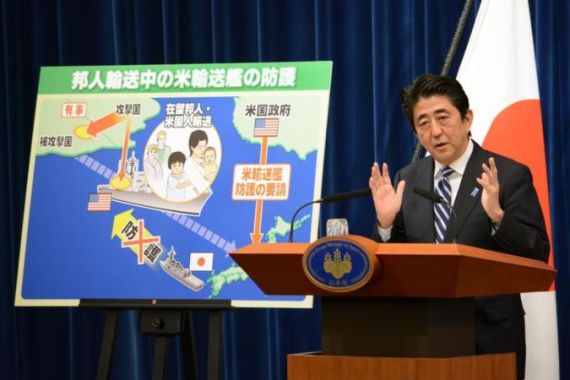Quakes in Japan’s pacifism
Japan’s prime minister is attempting to revise constitutional pacifism to allow for strengthening of armed forces.

On May 15, Japan’s Prime Minister Shinzo Abe made public his plan to gut the country’s peace constitution by allowing its Self-Defence Force (SDF) to use force overseas. The ruling Liberal Democratic Party (LDP) has long sought to amend Article 9, which renounces war and prohibits maintenance of war potential, the economic capability of a nation to wage war, through an overall constitutional revision. However, due to significant public opposition, Abe has changed his strategy and is now trying to revise not the text of the constitution, but its interpretation. Such a move would make the fundamental peace clause a dead letter and signal a sharp departure from Japan’s traditionally restrained defence policy.
Abe’s plan is to change Article 9’s interpretation through a cabinet decision without approval by the Japan’s parliament called the National Diet in the coming months. This backdoor tactic has attracted much criticism, even among those who support an eventual amendment for bypassing the formal procedure for constitutional revision, which requires a national referendum. It remains unclear whether Abe will get his way, since ruling coalition partner New Komeito, a Buddhist party, strongly resists the move. There are also significant voices of concern within the LDP about a process that neglects the formal Diet procedure.
Constitutional re-interpretation is a part of Abe’s overall military and foreign policies pursued in the name of “proactive pacifism”. It seeks to develop a stronger capacity to defend Japan’s territorial claims over the disputed islands from China, broader military cooperation with the US, and military activities overseas to secure Japanese corporate interests, including the pursuit of natural resources. In the last year and a half, as part of this policy, Abe’s government has formulated a new national security strategy, increased its military budget for two fiscal years and abandoned the long-held arms export ban. Abe is now trying to remove the constitutional restraints that have limited Japan’s military to a purely defensive role.
|
|
| 101 East – Japan: The next wave |
Claimed to be part of his declared commitment to “proactively contribute to international peace”, these initiatives are in fact driven by Abe’s personal ideological ambitions. His political agenda as a right-wing nationalist has been to break away from the post-World War II regime imposed during the US occupation and realise a “proud and strong Japan”. Abe’s visit to the Yasukuni Shrine that honours Class-A war criminals and offensive remarks by Japanese top officials, including wartime sexual slavery, are part of this nationalism associated with historical revisionism.
Such right-wing rhetoric resonates with the growing nationalistic sentiments that are taking root in Japanese society. This unfortunate reality can be explained by a number of factors – the long-lasting economic stagnation that has disturbed social stability, the correlated decrease of power internationally, the loss of confidence felt especially among the younger generation, and, against this backdrop, the rise of China. “National unity” slogans in the aftermath of the March 2011 tsunami, coupled with an extraordinary lack of public education regarding Japan’s wartime history, have contributed to making young Japanese amenable to nationalist and historical revisionist claims.
Abe seems eager to be remembered in history as the man who brought Japan back to normality. His latest move is a relatively modest proposal compared to what had been anticipated: It focuses on scenarios such as rescuing Japanese citizens residing overseas. However, lifting constitutional restraint for the use of force may pave the way to further and more significant changes in the future.
Renunciation of war was the oath by post-WWII Japan not to repeat its mistakes. Changing its interpretation would have serious consequences internationally, especially on the fragile stability in Northeast Asia. Tensions between Japan, China, and the Koreas over territorial disputes, historical issues, and nuclear weapons programs are already severe enough. Abe’s move threatens to exacerbate them.
Opinion polls show that a clear majority of Japanese opposes the re-interpretation of Article 9 as proposed by Abe. Thousands of people have protested in Tokyo against making Japan “a country that can wage war.” Japan’s peace movement is vibrant, but it also faces challenges. Notably, how to deal with growing nationalism, and how to respond to criticisms that Japan’s pacifism is self-righteous and the country does not shoulder its share of international responsibilities.
Article 9 can work as an international mechanism for peace that promotes disarmament and non-military solutions to disputes, through dialogue, confidence-building, mediation, and international laws. It also encourages human security cooperation on disasters, diseases and humanitarian affairs, while advocating for coordinated reduction of military spending. Japan can play a leading role, particularly in nuclear disarmament and arms trade control. Real proactive pacifism lies in Article 9.
Measures to promote dialogue among East Asian countries – for both reconciliation and risk reduction – are a matter of urgency. Any provocation by countries in the region will be counterproductive. And international support is needed to prevent the quakes of nationalism and militarism from getting out of control. Japan has much to learn from Europe’s post-war reconciliation experience, which can help convince the country that its commitment to peace remains something it can be proud of.
Akira Kawasaki is Executive Committee member of Peace Boat.
Celine Nahory is Coordinator of Global Article 9 Campaign to Abolish War.